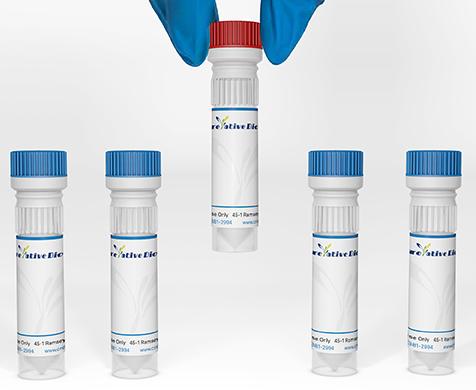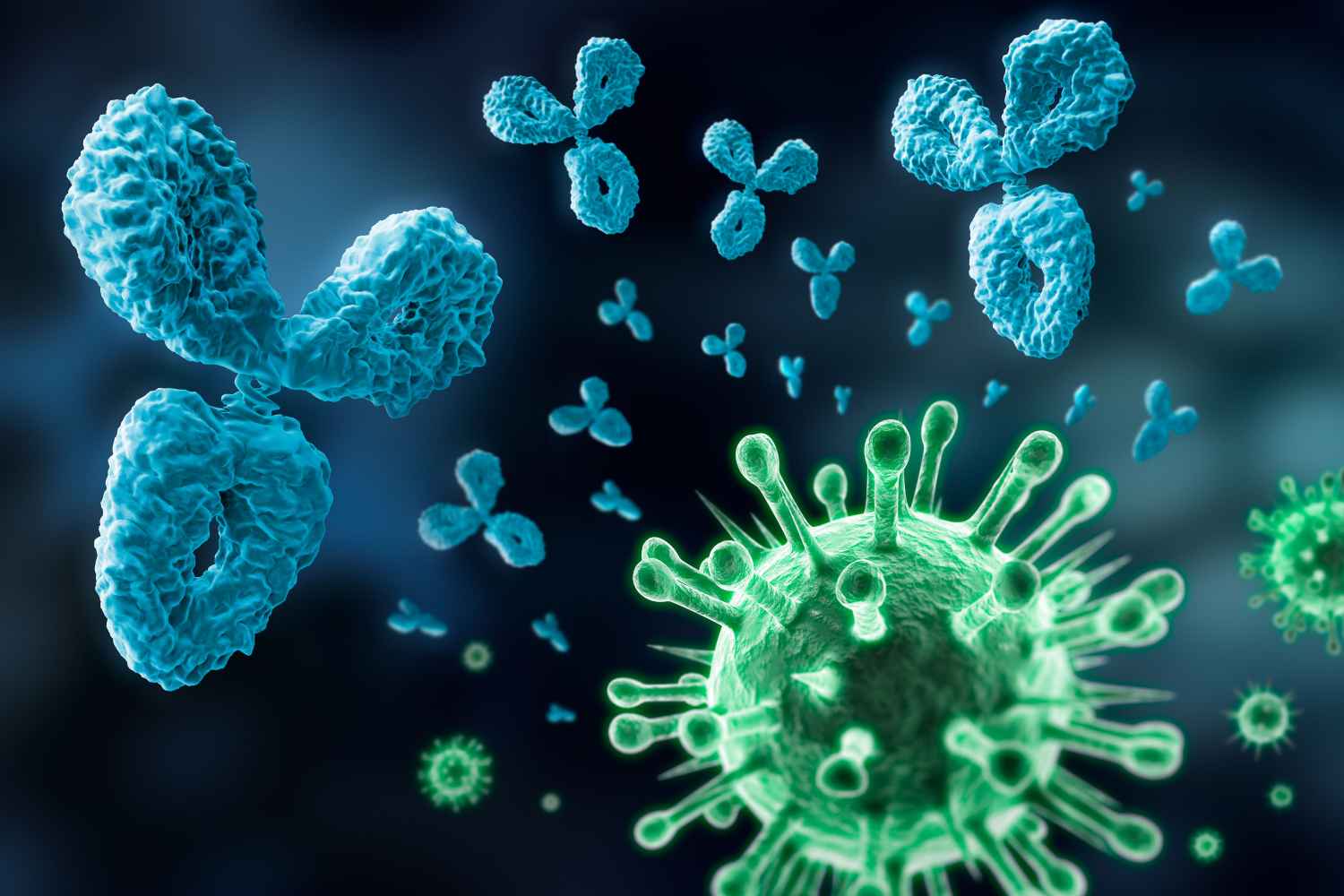HCFC1
This gene is a member of the host cell factor family and encodes a protein with five Kelch repeats, a fibronectin-like motif, and six HCF repeats, each of which contains a highly specific cleavage signal. This nuclear coactivator is proteolytically cleaved at one of the six possible sites, resulting in the creation of an N-terminal chain and the corresponding C-terminal chain. The final form of this protein consists of noncovalently bound N- and C-terminal chains. The protein is involved in control of the cell cycle and transcriptional regulation during herpes simplex virus infection. Alternatively spliced variants which encode different protein isoforms have been described; however, not all variants have been fully characterized.
Full Name
host cell factor C1
Function
Transcriptional coregulator (By similarity).
Involved in control of the cell cycle (PubMed:10629049, PubMed:10779346, PubMed:15190068, PubMed:16624878, PubMed:23629655).
Also antagonizes transactivation by ZBTB17 and GABP2; represses ZBTB17 activation of the p15(INK4b) promoter and inhibits its ability to recruit p300 (PubMed:10675337, PubMed:12244100).
Coactivator for EGR2 and GABP2 (PubMed:12244100, PubMed:14532282).
Tethers the chromatin modifying Set1/Ash2 histone H3 'Lys-4' methyltransferase (H3K4me) and Sin3 histone deacetylase (HDAC) complexes (involved in the activation and repression of transcription, respectively) together (PubMed:12670868).
Component of a THAP1/THAP3-HCFC1-OGT complex that is required for the regulation of the transcriptional activity of RRM1 (PubMed:20200153).
As part of the NSL complex it may be involved in acetylation of nucleosomal histone H4 on several lysine residues (PubMed:20018852).
Recruits KMT2E/MLL5 to E2F1 responsive promoters promoting transcriptional activation and thereby facilitates G1 to S phase transition (PubMed:23629655).
Modulates expression of homeobox protein PDX1, perhaps acting in concert with transcription factor E2F1, thereby regulating pancreatic beta-cell growth and glucose-stimulated insulin secretion (By similarity).
May negatively modulate transcriptional activity of FOXO3 (By similarity).
(Microbial infection) In case of human herpes simplex virus (HSV) infection, HCFC1 forms a multiprotein-DNA complex with the viral transactivator protein VP16 and POU2F1 thereby enabling the transcription of the viral immediate early genes.
Involved in control of the cell cycle (PubMed:10629049, PubMed:10779346, PubMed:15190068, PubMed:16624878, PubMed:23629655).
Also antagonizes transactivation by ZBTB17 and GABP2; represses ZBTB17 activation of the p15(INK4b) promoter and inhibits its ability to recruit p300 (PubMed:10675337, PubMed:12244100).
Coactivator for EGR2 and GABP2 (PubMed:12244100, PubMed:14532282).
Tethers the chromatin modifying Set1/Ash2 histone H3 'Lys-4' methyltransferase (H3K4me) and Sin3 histone deacetylase (HDAC) complexes (involved in the activation and repression of transcription, respectively) together (PubMed:12670868).
Component of a THAP1/THAP3-HCFC1-OGT complex that is required for the regulation of the transcriptional activity of RRM1 (PubMed:20200153).
As part of the NSL complex it may be involved in acetylation of nucleosomal histone H4 on several lysine residues (PubMed:20018852).
Recruits KMT2E/MLL5 to E2F1 responsive promoters promoting transcriptional activation and thereby facilitates G1 to S phase transition (PubMed:23629655).
Modulates expression of homeobox protein PDX1, perhaps acting in concert with transcription factor E2F1, thereby regulating pancreatic beta-cell growth and glucose-stimulated insulin secretion (By similarity).
May negatively modulate transcriptional activity of FOXO3 (By similarity).
(Microbial infection) In case of human herpes simplex virus (HSV) infection, HCFC1 forms a multiprotein-DNA complex with the viral transactivator protein VP16 and POU2F1 thereby enabling the transcription of the viral immediate early genes.
Biological Process
Cell cycle Source: UniProtKB-KW
Chromatin remodeling Source: GO_Central
Histone H4-K16 acetylation Source: UniProtKB
Histone H4-K5 acetylation Source: UniProtKB
Histone H4-K8 acetylation Source: UniProtKB
Negative regulation of transcription by RNA polymerase II Source: UniProtKB
Positive regulation of cell cycle Source: UniProtKB
Positive regulation of gene expression Source: UniProtKB
Positive regulation of histone H3-K4 methylation Source: ComplexPortal
Positive regulation of transcription, DNA-templated Source: UniProtKB
Positive regulation of transcription by RNA polymerase II Source: ARUK-UCL
Protein stabilization Source: UniProtKB
Regulation of protein-containing complex assembly Source: UniProtKB
Regulation of transcription, DNA-templated Source: UniProtKB
Release from viral latency Source: UniProtKB
Chromatin remodeling Source: GO_Central
Histone H4-K16 acetylation Source: UniProtKB
Histone H4-K5 acetylation Source: UniProtKB
Histone H4-K8 acetylation Source: UniProtKB
Negative regulation of transcription by RNA polymerase II Source: UniProtKB
Positive regulation of cell cycle Source: UniProtKB
Positive regulation of gene expression Source: UniProtKB
Positive regulation of histone H3-K4 methylation Source: ComplexPortal
Positive regulation of transcription, DNA-templated Source: UniProtKB
Positive regulation of transcription by RNA polymerase II Source: ARUK-UCL
Protein stabilization Source: UniProtKB
Regulation of protein-containing complex assembly Source: UniProtKB
Regulation of transcription, DNA-templated Source: UniProtKB
Release from viral latency Source: UniProtKB
Cellular Location
Cytoplasm; Nucleus. HCFC1R1 modulates its subcellular localization and overexpression of HCFC1R1 leads to accumulation of HCFC1 in the cytoplasm (PubMed:12235138). Non-processed HCFC1 associates with chromatin. Colocalizes with CREB3 and CANX in the ER.
Involvement in disease
Mental retardation, X-linked 3 (MRX3):
A disorder characterized by significantly below average general intellectual functioning associated with impairments in adaptive behavior and manifested during the developmental period. Intellectual deficiency is the only primary symptom of non-syndromic X-linked mental retardation, while syndromic mental retardation presents with associated physical, neurological and/or psychiatric manifestations.
A disorder characterized by significantly below average general intellectual functioning associated with impairments in adaptive behavior and manifested during the developmental period. Intellectual deficiency is the only primary symptom of non-syndromic X-linked mental retardation, while syndromic mental retardation presents with associated physical, neurological and/or psychiatric manifestations.
PTM
Proteolytically cleaved at one or several PPCE--THET sites within the HCF repeats (PubMed:7590226, PubMed:10920196, PubMed:21285374). Further cleavage of the primary N- and C-terminal chains results in a 'trimming' and accumulation of the smaller chains. Cleavage is promoted by O-glycosylation (PubMed:21285374, PubMed:28302723, PubMed:28584052).
O-glycosylated. GlcNAcylation by OGT promotes proteolytic processing.
Ubiquitinated. Lys-1807 and Lys-1808 are ubiquitinated both via 'Lys-48'- and 'Lys-63'-linked polyubiquitin chains. BAP1 mediated deubiquitination of 'Lys-48'-linked polyubiquitin chains; deubiquitination by BAP1 does not seem to stabilize the protein.
O-glycosylated. GlcNAcylation by OGT promotes proteolytic processing.
Ubiquitinated. Lys-1807 and Lys-1808 are ubiquitinated both via 'Lys-48'- and 'Lys-63'-linked polyubiquitin chains. BAP1 mediated deubiquitination of 'Lys-48'-linked polyubiquitin chains; deubiquitination by BAP1 does not seem to stabilize the protein.
View more
Anti-HCFC1 antibodies
+ Filters
 Loading...
Loading...
Target: HCFC1
Host: Rabbit
Antibody Isotype: IgG
Specificity: Human, Mouse
Clone: EG1486
Application*: IHC: 1:50~1:100 ELISA: 1:20000
More Infomation
Hot products 
-
Mouse Anti-DLL4 Recombinant Antibody (D1090) (CBMAB-D1090-YC)

-
Mouse Anti-ACTB Recombinant Antibody (V2-179553) (CBMAB-A0870-YC)

-
Mouse Anti-BZLF1 Recombinant Antibody (BZ.1) (CBMAB-AP705LY)

-
Mouse Anti-AGO2 Recombinant Antibody (V2-634169) (CBMAB-AP203LY)

-
Rat Anti-(1-5)-α-L-Arabinan Recombinant Antibody (V2-501861) (CBMAB-XB0003-YC)

-
Rat Anti-ADGRE4 Recombinant Antibody (V2-160163) (CBMAB-F0011-CQ)

-
Mouse Anti-BMI1 Recombinant Antibody (CBYC-P026) (CBMAB-P0108-YC)

-
Mouse Anti-ENO2 Recombinant Antibody (H14) (CBMAB-E1341-FY)

-
Mouse Anti-CAT Recombinant Antibody (724810) (CBMAB-C8431-LY)

-
Mouse Anti-CD33 Recombinant Antibody (6C5/2) (CBMAB-C8126-LY)

-
Human Anti-SARS-CoV-2 Spike Recombinant Antibody (CR3022) (CBMAB-CR014LY)

-
Mouse Anti-AMOT Recombinant Antibody (CBYC-A564) (CBMAB-A2552-YC)

-
Mouse Anti-AKT1/AKT2/AKT3 (Phosphorylated T308, T309, T305) Recombinant Antibody (V2-443454) (PTM-CBMAB-0030YC)

-
Rat Anti-CCR2 Recombinant Antibody (475301) (CBMAB-C1338-LY)

-
Mouse Anti-ARID1B Recombinant Antibody (KMN1) (CBMAB-A3546-YC)

-
Mouse Anti-Acetyl-α-Tubulin (Lys40) Recombinant Antibody (V2-623485) (CBMAB-CP2897-LY)

-
Mouse Anti-ATM Recombinant Antibody (2C1) (CBMAB-A3970-YC)

-
Mouse Anti-APP Recombinant Antibody (DE2B4) (CBMAB-1122-CN)

-
Mouse Anti-CEMIP Recombinant Antibody (3C12) (CBMAB-K0296-LY)

-
Mouse Anti-BCL2L1 Recombinant Antibody (H5) (CBMAB-1025CQ)

For Research Use Only. Not For Clinical Use.
(P): Predicted
* Abbreviations
- AActivation
- AGAgonist
- APApoptosis
- BBlocking
- BABioassay
- BIBioimaging
- CImmunohistochemistry-Frozen Sections
- CIChromatin Immunoprecipitation
- CTCytotoxicity
- CSCostimulation
- DDepletion
- DBDot Blot
- EELISA
- ECELISA(Cap)
- EDELISA(Det)
- ESELISpot
- EMElectron Microscopy
- FFlow Cytometry
- FNFunction Assay
- GSGel Supershift
- IInhibition
- IAEnzyme Immunoassay
- ICImmunocytochemistry
- IDImmunodiffusion
- IEImmunoelectrophoresis
- IFImmunofluorescence
- IGImmunochromatography
- IHImmunohistochemistry
- IMImmunomicroscopy
- IOImmunoassay
- IPImmunoprecipitation
- ISIntracellular Staining for Flow Cytometry
- LALuminex Assay
- LFLateral Flow Immunoassay
- MMicroarray
- MCMass Cytometry/CyTOF
- MDMeDIP
- MSElectrophoretic Mobility Shift Assay
- NNeutralization
- PImmunohistologyp-Paraffin Sections
- PAPeptide Array
- PEPeptide ELISA
- PLProximity Ligation Assay
- RRadioimmunoassay
- SStimulation
- SESandwich ELISA
- SHIn situ hybridization
- TCTissue Culture
- WBWestern Blot

Online Inquiry





